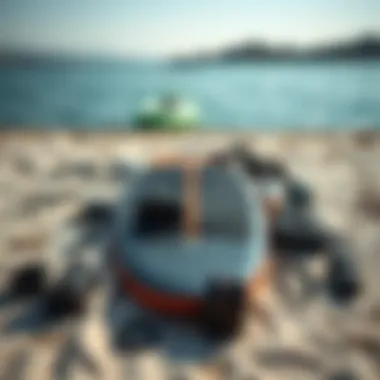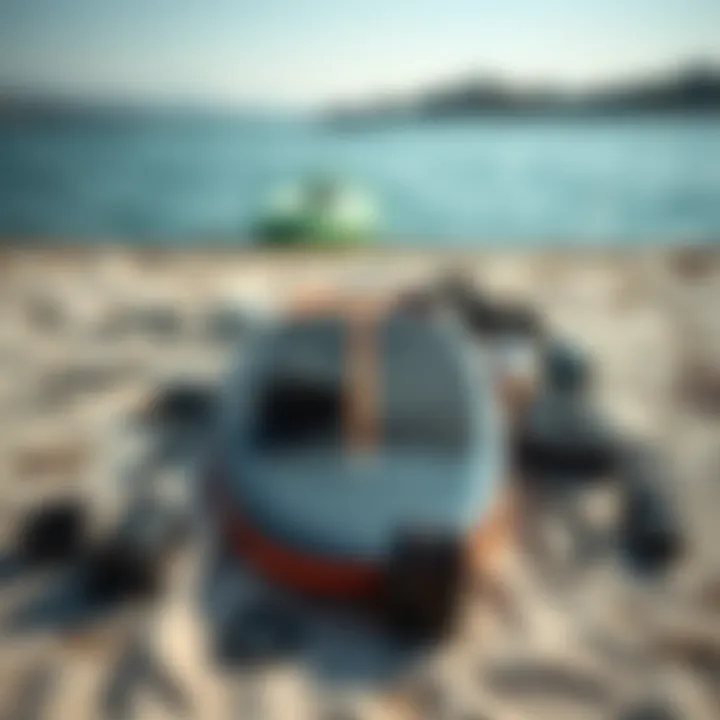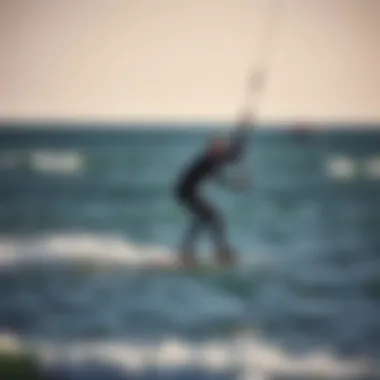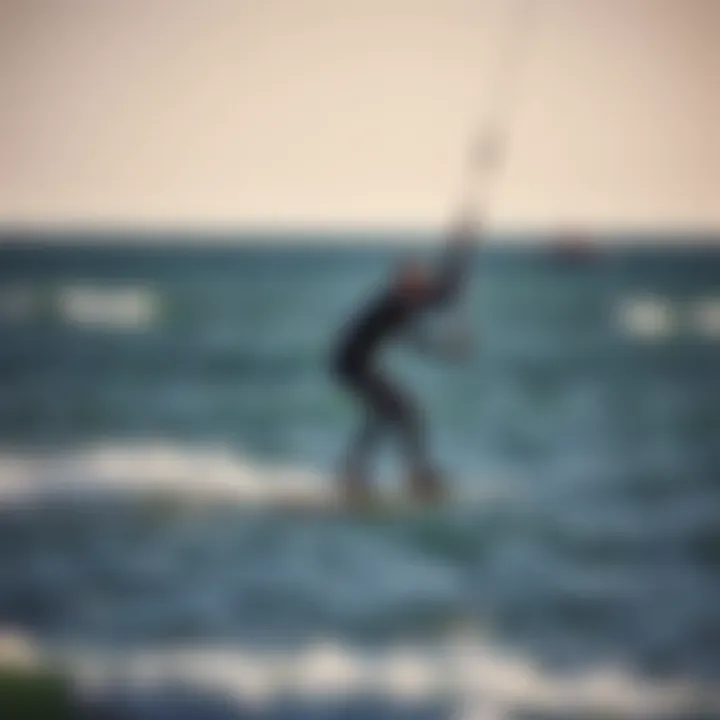Beginner Foil Board: Your Ultimate Guide to Starting


Intro
Foil boarding is an exhilarating sport that combines aspects of surfing, kiteboarding, and even windsurfing. As newcomers step into this world, it's crucial to understand the foundational elements and techniques that can facilitate a smoother transition. This guide is tailored for those ready to explore the waters with a foil board. With an emphasis on gear selection, skill development, and safety considerations, beginners will find the necessary tools to enjoy this thrilling experience while also fostering an awareness of the sport's impact on the environment.
Gear Selection
The right gear can make or break your foil boarding experience. Understanding different components and how they work together is essential for optimal performance and safety.
Types of Kites
When selecting a kite for foil boarding, consider this: not all kites are created equal. Different types serve various purposes. Some common varieties include:
- Delta Kites: These kites are stable and easy to fly. They handle a range of wind conditions well.
- C-Kites: Known for their sheer power and maneuverability, these kites can be thrilling to use, especially for aerial tricks.
- Bow Kites: Designed to provide a smoother ride in varying wind conditions, bow kites often give more control and power.
Each kite has its own strengths and weaknesses. It's wise to think about your skill level and the type of conditions you’ll be in. For rookies, a delta kite may just be the way to go until you gain some confidence.
Choosing the Right Board
The board is where you’ll set your feet and balance yourself, so it’s no small matter when it comes to selection. Factors to consider include:
- Size: Larger boards provide more stability, which is ideal for beginners. However, as your skills improve, you may want to move to a smaller board for better agility.
- Foil Design: There are several foil designs that include high aspect and low aspect foils. Each provides different advantages for speed and lift. High aspect foils are typically more efficient in flat water, whereas low aspect foils may offer better lift degree.
- Material: The board’s construction determines its weight and durability. Lightweight boards allow for easier maneuvering, but they might sacrifice some sturdiness.
In providing the right conditions for beginners, it becomes important to approach both kite and board selection with consideration for wind conditions, your weight, and where you’ll primarily be boarding.
Skill Development
Once you’ve gathered your gear, honing your skills is the next step in your foil boarding journey. This involves not just riding but mastering techniques that allow for safe and impressive performances on the water.
Essential Techniques
One cannot simply hop on a foil board and expect to glide flawlessly. Some essential techniques include:
- Body Positioning: The way you stand can greatly affect your balance. A neutral stance is key.
- Board Control: Learning to control how the board reacts in different waves or wind conditions is crucial. Practice makes perfect.
- Foil Awareness: Understanding how to feel and respond to the lift is a skill. You should know when to push down for stability or lift up for those aerial moments.
Progression Tips
As you get more comfortable, it’s important to push your limits responsibly. Here are some progression tips:
- Start Small: Don’t rush into advanced tricks; take your time with the basics.
- Set Goals: Regularly challenge yourself with achievable objectives.
- Learn from Others: Engaging with a community or instructor can provide insights that are hard to acquire on your own.
In the world of foil boarding, safety should always come first. Never hesitate to prioritize it, especially as you learn and grow your skills.
Safety first, thrill later.
Resources for Further Learning
For those keen on delving deeper into the technical aspects of foil boarding, numerous resources can aid your journey:
- Wikipedia on Kiteboarding
- Britannica
- Community discussions on Reddit
- Information on safety practices can often be found through .gov or .edu domains,
With a sturdy foundation in gear selection and skill development, you will be better equipped to handle the thrilling waters of foil boarding. As it's a sport that requires patience and practice, be mindful of your environment and the community, ensuring positive practices that respect both the sport and the natural world.
Intro to Foil Boarding
As the sport of foil boarding continues to gain traction, understanding its core elements is essential for anyone looking to dip their toes into this captivating discipline. Foil boarding combines the thrill of riding the water with the exhilarating dynamics of flight, setting the stage for a unique experience that marries skill, balance, and ingenuity. This opens up not just a new realm for enthusiasts but also promotes a burgeoning community of like-minded adventurers.
The significance of introducing foil boarding lies in the myriad benefits it offers to participants. For one, it enhances one's ability to read the water and harness its energies—skills that transcend foil boarding and can be valuable in various water sports. Moreover, foil boarding stimulates core strength, balance, and confidence while providing unmediated access to serene and stunning aquatic environments.
Definition and Overview
At its core, foil boarding revolves around the use of a hydrofoil—a specialized board that elevates the rider above the water's surface, significantly reducing drag. The design includes a fin, or foil, submerged below the board that lifts it into the air as speed increases. This unique ability to glide above the water allows riders to navigate through choppy waters with ease and gives them a sensation akin to flying.
The sport encompasses various styles, including kite foil boarding and sup foiling, each offering distinct experiences and methods of propulsion.
Historical Context


Foil boarding’s roots can be traced back to innovations in surfing and windsurfing, with the hydrofoil concept originating in the early 1900s. Engineers and inventors experimented with the idea, leading to its adoption in racing vessels throughout the decades. However, it was not until the late 20th century that the design found its way into the recreational realm of water sports.
In more recent years, advancements in materials and construction have allowed ease of use and accessibility for novices, minimizing the learning curve associated with traditional boarding techniques. The progression from a niche pastime to a widespread sport highlights the exhilarating appeal of being lifted above the water, paving the way for a community that both respects innovation and cherishes traditional maritime culture.
"Foil boarding is not just a sport; it's about experiencing nature in a new way, where every ride offers a fresh perspective."
As we delve deeper into the anatomy of foil board equipment and techniques, readers will discover how to equip themselves effectively and safely embark on their thrill-seeking journey.
Understanding Foil Board Equipment
Understanding the various components of foil boarding equipment is critical for anyone looking to embark on this thrilling journey. It’s not just about having the right gear; it’s about knowing how each piece works together to create a seamless experience on the water. Grasping this topic ensures that beginners can make informed decisions when selecting their gear, as well as optimizing their performance and safety while riding. Let’s break this down into manageable pieces.
Foil Board Anatomy
Board Types
When diving into the world of foil boarding, recognizing the different board types is essential. Each type caters to specific riding styles and abilities. For instance, there are surf foil boards designed for waves and hydrofoil boards tailored for flatwater or speed. The key distinction lies in the shape and size of the board. A surf foil board typically has a wider nose and a slightly shorter length, which helps in catching waves, while flatwater boards can be longer and sleeker for speed and stability.
The popularity of these variations stems from their unique features. For beginners, a wider board enables greater stability during rides, allowing for a more forgiving introduction to the sport. However, it may limit speed. Picking the right type means aligning it with your aspirations, whether you want to ride the waves or cruise over calm waters.
Foil Components
Foiling consists of two primary components: the foil and mast assembly. The foil itself comprises the front wing, back wing, and fuselage. Each element plays a pivotal role in providing lift when you achieve enough speed. The design and orientation of these components determine how the foil behaves in water.
For beginners, understanding that a larger front wing generates more lift at lower speeds makes it a preferable choice. Conversely, while smaller wings might seem advantageous due to their speed capabilities, they generally require more skill to control effectively. Select components that complement your current skill level and desired style - flexibility in choices can greatly enhance your learning curve.
Materials and Construction
The materials and construction techniques used in foil boards matter significantly. Most boards are crafted from lightweight materials like carbon fiber and fiberglass, providing the right balance between durability and performance. These materials contribute to an optimal experience on the water as they resist damage and maintain integrity over time.
Choosing a board made of quality materials means investing in safety and performance. For beginners, it’s often wise to opt for boards that strike a harmony between weight and sturdiness, as they are more forgiving during falls and mishaps. Construction methods, like how the layers are bonded together, can also influence performance; a well-constructed board can make all the difference.
Choosing the Right Foil Board
Assessing Skill Level
Before you grab your gear, assessing your skill level is indispensable. Foil boarding is unique in that it requires a specific understanding of balance and control, something not all traditional water sports share. Beginners should take a straight approach: it’s generally better to start with gear that matches their current skill set, rather than overestimating.
Why? Using advanced boards can lead to frustration and diminishing motivation. Finding a board designed for your level enhances the learning process, allowing room for gradual progression.
Weight Considerations
Understanding weight considerations ensures that you select the right equipment tailored to your physical size and conditions. Heavier individuals often need boards with more volume to float effectively and generate lift. This is a crucial aspect because riding on an inadequate board can lead to laborious paddling and eventual fatigue.
By paying attention to the weight dynamics, beginners can experience smoother rides, which helps in boosting confidence and skill retention.
Recommended Models for Beginners
There are a plethora of brands out there, each offering an array of models suitable for beginners. Depending on individual preferences, looking into names like Slingshot Hover Glide or Naish Hover could be a great start. These models typically feature wide boards with stable designs, ideal for those just getting their feet wet.
Exploring beginner-focused models means prioritizing appealing features, such as ease of use, controls, and adaptability. Having the backing of reputable brands often means reliable customer service and more substantial community support. Plus, you get the benefit of learning from the experiences of others.
In summary, understanding foil boarding equipment equips beginners with the necessary insights to make informed decisions, ultimately leading to a rewarding experience on the water. By selecting the right board type, components, materials, and models that align with personal preferences, you set the stage for a successful journey into foil boarding.
Techniques for Beginners
When venturing into the realm of foil boarding, having a solid grasp of the fundamental techniques can be the linchpin for a gratifying experience. Mastering these methods not only boosts confidence but also lays the groundwork for more advanced skills. The journey from being a novice to a competent foil boarder involves understanding the water's embrace, harnessing wind dynamics, and maintaining a balanced presence on the board. Not only do these skills serve to enhance your performance, but they also cultivate a deeper appreciation for the sport.
Getting Started on the Water
Preparation and Launching
Preparation and launching may seem like mere chores before hitting the waves, but they play a crucial role in the overall experience of foil boarding. A well-executed launch sets the stage for a successful session on the water. One key characteristic of preparation is ensuring that all gear is assembled and functioning—this means double-checking your bindings, foil attachment, and safety equipment. It’s a beneficial choice to have a routine for launching; it helps instill confidence and efficiency in what can be a chaotic moment.
Unique features of a smooth launching include utilizing the right wind conditions and correct body positioning. However, the downside could be the initial frustration of learning proper timing. Beginners often find the task a bit daunting, but sticking to the basics makes it rewarding.
Harnessing Wind and Water Dynamics


Harnessing the intricate dance of wind and water is at the heart of foil boarding. Understanding how to read the environment can significantly enhance your enjoyment and performance. One of the key elements here is assessing wind direction and strength, which helps in planning your routes and maneuvers effectively. The beauty of mastering this skill lies in the sensation of gliding across water with control and ease.
What makes this aspect popular among beginners is the immediate feedback received from the conditions. If you get it right, you’ll feel like you’re flying; if not, well, it offers a steep yet educational learning curve. The ability to manipulate wind and water dynamics can open doors to various riding styles, yet its difficulty lies in its fluid nature – what works one day may not the next.
Basic Riding Techniques
Balance and Stance
Balance and stance are your bread and butter for foil boarding. A strong stance lays the groundwork for everything you do while riding. The essential aspect revolves around the distribution of weight; a centered position can ensure that you stabilize well on the board. When standing correctly, having knees slightly bent is crucial—it lowers your center of gravity and grants you better control.
Moreover, this method is favored among beginners as it promotes long-lasting comfort and reduces the chances of falling. A unique feature of a good stance is the placement of feet—widely spaced offers better stability. Even so, some riders struggle during transitions, making balance a double-edged sword that requires constant attention.
Directional Control
Directional control is pivotal for maneuvering around obstacles and engaging fully in the foil boarding experience. By learning to shift your weight and adjust your board angle, you will be able to dictate your path. The essential characteristic of this skill is the connection between your body and the board; knowing how to shift your weight effectively while remaining relaxed can lead to fluid movement over the water.
This approach is a popular choice among beginners because once mastered, it offers a sense of freedom and adaptability. However, the unique challenge lies in the fine line between control and overcorrection, where too much movement can throw the rider off balance.
Stopping Techniques
Learning effective stopping techniques is as necessary as knowing how to get started. Understanding when and how to stop can serve as a safety mechanism and also a confident move among peers. One of the standout aspects of stopping techniques is learning to use drag by tilting the board to slice through the water. This not only helps in controlled stops, but it also builds a skill set for slowing down safely.
This technique is beneficial since it allows riders to maintain control even in tricky water conditions. The unique intersection of safety and skill in stopping means that even as a beginner, with practice, you can manage unexpected situations adeptly. One downside might be that learners sometimes struggle to gauge distance effectively, leading to premature or abrupt stops.
Advancing Your Skills
Small Jumps and Tricks
As you settle into the rhythm of foil boarding, trying out small jumps and tricks becomes an attractive avenue for advancement. These maneuvers not only enhance your skill set but also introduce an element of thrill to the experience. One key factor in performing small jumps is timing; the right moment can make all the difference.
This aspect excites novices because it offers an opportunity to express creativity and discernible progress. However, it can be a double-edged sword where falling becomes a real risk. This highlights the importance of gradual progression—celebrate those small wins while emphasizing safety.
Turning and Maneuvering
Turning and maneuvering are essential skills for anyone looking to refine their boarding style. This skill hinges on your ability to initiate turns smoothly while balancing the weight distribution on the board. A hallmark of turning well is mastering the edge of the board; use of the foil’s lift subtly alters your center of gravity to shift directions.
This technique is crucial because it helps in navigating tight spots, making the experience both exciting and practical for everyday riding. Beginners often appreciate the sheer adaptability that comes with being able to turn efficiently, yet it does demand practice—novices can feel overwhelmed without consistent focus on form.
Safety Considerations
Safety is paramount in any sport, and foil boarding is no exception. Engaging in this exhilarating activity comes with its own set of risks; thus, understanding and implementing safety considerations becomes crucial. The right safety gear, knowledge of local regulations, awareness of weather conditions, and water safety practices all play significant roles in minimizing danger while maximizing enjoyment on the water.
Essential Safety Gear
Wetsuits and Impact Vests
When it comes to safety gear, wetsuits and impact vests are non-negotiable. A wetsuit serves two main purposes: it keeps you warm in cool water and helps provide buoyancy. The material is typically made from neoprene, which not only insulates but also allows flexibility while moving. An impact vest, on the other hand, offers protection against those occasional falls or hits you might take on the board. Its padded design can help cushion impacts, especially for beginners still getting their feet wet, so to speak.
A key characteristic of these garments is their snug fit. They are designed to move with you, ensuring you don’t feel restricted, which makes them a popular choice for anyone starting out. However, they can be tricky to put on, particularly when they are new. A unique advantage of wetsuits is that they come in various thicknesses, allowing you to choose one based on the water temperature you’ll be dealing with—this adaptability can greatly enhance your comfort and safety.
Helmets and Leashes
Equally as important are helmets and leashes. A helmet is your best friend when it comes to head protection; it guards against potential injuries, especially when you’re still mastering balance on the board. Lightweight, water-friendly helmets are often the preferred choice, as they provide safety without feeling cumbersome.
Leashes are essential too. They attach the foil board to you, so in case you wipe out, the board doesn’t drift off into open water, and you can quickly retrieve it. The characteristic design of a good leash should be both durable and lightweight. That said, care must be taken while using these leashes; they can become cumbersome if not managed properly, and they sometimes cause entanglement in rough conditions. Yet, establishing this connection between you and your board ensures a safer outing overall.
Understanding the Environment
Local Regulations
Every body of water has its own rules, and understanding local regulations is vital for responsible foil boarding. These regulations exist to protect both the environment and the riders. By adhering to designated zones, you ensure that wildlife and other water users are not disturbed, allowing for a more harmonious experience on the water.
A unique feature of local regulations often includes speed limits or no-wake zones in certain areas, which aim to protect marine life and keep everyone safe. Understanding these guidelines helps prevent accidents and promotes a positive relationship between foil boarders and local authorities. Awareness of these regulations can save you from hefty fines and, more importantly, from potential dangerous encounters with other watercrafts.
Weather Conditions
Weather plays a critical role in your foil boarding outing. Wind strength, for instance, can make or break your experience. A windy day can be thrilling, but it can also be treacherous for beginners who are still mastering the balance of launching off the waves. Checking forecasts for wind direction and intensity beforehand is a savvy move.


In this context, recognizing signs of sudden weather changes—like darkening clouds or shifts in wind direction—can protect you from unexpected storms. Always keep an eye out and know when to call it a day. Being aware of these nuances can save you from a hard lesson about nature's unpredictability.
Water Safety Practices
Lastly, water safety practices round out the essential components of a safe foil boarding experience. It’s important to have fundamental knowledge of how to navigate the waters you’ll be riding. This includes understanding currents, potential hazards, and basic swimming skills should an unexpected fall occur.
A key characteristic of water safety practices is the buddy system—riding with a partner can significantly enhance safety, allowing you to watch each other’s back. In some locales, there might be organized foam boarding groups that provide the added benefit of community knowledge about specific local hazards and tips. However, no matter how experienced you think you are, never underestimate the water. Consistent vigilance and preparedness are fundamental to enjoying this thrilling sport safely.
Environmental Impact and Responsibility
Foil boarding, while exhilarating, doesn’t come without its environmental responsibilities. It's essential for enthusiasts to recognize that their passion for water sports can affect nature. Understanding and addressing the environmental impact not only preserves natural beauty but also ensures that future generations can enjoy the same thrill of foil boarding. These considerations encompass sustainable practices and community engagement that actively contribute to a healthier ecosystem.
Sustainable Practices
Reducing Pollution
Reducing pollution is a pivotal part of engaging in water sports like foil boarding. When riders commit to keeping waterways clean and minimizing waste, they foster a healthier environment. A key characteristic of reducing pollution is the active avoidance of single-use plastics, which often find their way into oceans. This practice is not only beneficial but also wise—it lowers the risk of entangling marine life, which is a common worry for those who cherish aquatic ecosystems.
One unique feature of reducing pollution is the community’s collective responsibility. By forming groups to monitor trash and encouraging each other to bring reusable items, everyone plays a part. The advantage of this engagement is obvious: cleaner water, more vibrant ecosystems, and an enhanced experience for everyone on the water.
"The ocean is a shared space that needs our care—every bit counts!"
However, there are also disadvantages. Sometimes, the effort required to organize clean-ups can feel like a burden. Yet, the long-term benefits far outweigh the inconveniences.
Respecting Wildlife
Respecting wildlife is crucial for maintaining the delicate balance of ocean environments. Every time a foil board touches the water, it’s a reminder that we share our space with countless marine creatures. A key characteristic of this practice is the awareness to avoid disturbing breeding or feeding grounds. This level of respect not only maintains biodiversity but also enhances the overall experience of being on the water.
By being conscious of personal behaviors—like avoiding noise before the dawn or steering clear of known wildlife areas—riders can enjoy their sport without overstepping nature's bounds. The advantage here is profound: thriving aquatic populations lead to richer ecosystems, which in turn enrich our foil boarding experiences. However, ignoring these practices could lead to humans intruding too much into marine habitats, which shifts the balance unfavorably.
Community Engagement
Participating in Clean-ups
One of the simplest yet most impactful ways to engage with the environment is by participating in clean-ups. Organizing or joining these events demonstrates the commitment to preserving the spaces we enjoy. A key characteristic of these clean-ups is the community spirit that nourishes camaraderie among fellow riders. This unity does more than just pick up trash; it cultivates lasting bonds.
The unique feature of clean-up events is they offer a dual benefit: contributing to cleaner environments while providing a chance to meet other foil boarding enthusiasts. This aspect of participation fosters a sense of belonging and responsibility. The advantage is clear—over time, these efforts can lead to significant positive changes in local ecosystems. Conversely, some individuals may feel they have no time to spare or see it as an inconvenience.
Joining Local Organizations
Joining local organizations centered around foil boarding can amplify one’s impact on the environment. Such groups often work on initiatives aimed at minimizing ecological footprints and promoting sustainability. A key characteristic of being involved in local organizations is the access to information and resources that foster responsible practices.
Moreover, these organizations often serve as platforms for collaboration, making it easier for like-minded individuals to come together and lead initiatives.
The unique feature here is that members often have the chance to partake in various events that cater to interests beyond foil boarding, enriching the experiences of those involved. The advantage lies in shared knowledge and collective actions that lead to meaningful environmental contributions. Nevertheless, time and commitment can be hurdles that deter participation.
By understanding the environmental obligations that come with foil boarding, individuals can create a lasting positive impact. Every small action counts. With a commitment to reducing pollution and respecting wildlife, along with engaging the community, enthusiasts can enjoy a sport they love while ensuring the health of our waters and ecosystems.
Resources for Continued Learning
As you embark on your foil boarding journey, the quest for knowledge doesn’t stop with this guide. The sport evolves, and so do techniques and gear. Accessing the right resources can make all the difference in enhancing your skills and enjoying your time on the water. These resources not only provide foundational knowledge but also open doors to connected communities, ensuring that you are well-equipped for your adventures.
Online Tutorials and Courses
In today’s digital age, the internet is teeming with valuable information on foil boarding. Engaging with online tutorials and courses can be a game changer. They cater to all levels, focusing on different aspects of the sport. Websites like YouTube offer a wealth of video content where experienced riders demonstrate techniques and provide tips in real-time. Even dedicated platforms like Learn Kiteboarding offer structured courses that cover everything from the ground up.
Don't underestimate the benefits of visual learning. Watching a pro tackle the waves can boost your confidence and help you grasp complex maneuvers. Plus, many online resources allow you to revisit sections as needed, ensuring that the techniques stick. Tutorials also often introduce new trends and styles, keeping you in the loop with foil boarding developments.
"Learning is like rowing upstream; not to advance is to drop back."
This wisdom resonates in the realm of foil boarding. The more you learn, the better you become.
Kiteboarding Communities and Forums
Joining kiteboarding communities and forums can elevate your foil boarding experience. Platforms like Reddit host communities where enthusiasts share their experiences, questions, and advice. Engaging with fellow riders opens avenues for learning that formal tutorials may not cover.
Participating in discussions allows you to tap into collective wisdom. Real-world experiences shared by others can give firsthand insights into local conditions, gear recommendations, and safety tips. Additionally, forums often present current events, competitions, and meet-ups, allowing you to make connections and discover opportunities for practice and social interaction.
Consider checking out Facebook groups dedicated to kiteboarding. Many users actively post about local conditions and gear sales, making them invaluable resource for anyone looking to dive deeper into the sport.
Books and Publications
While online resources are pivotal, traditional books and publications shouldn't be overlooked. They offer comprehensive insights packed into structured formats. Titles such as "Kiteboarding: The Ultimate Guide" or "How to Foil: The Complete Handbook" are often praised for their depth and clarity. These materials provide detailed explanations and are usually tailored to skill levels, encompassing beginner to advanced strategies.
Publications like Kiteboarding Magazine also provide current trends, gear tests, and interviews with seasoned riders. Subscribing to these can keep you well-informed about advancements in the sport. Whether you're on a break from riding or looking to invest in a training manual, having physical books can serve as excellent reference points.
Ultimately, incorporating a mix of online courses, community interactions, and traditional literature can significantly enhance your foil boarding knowledge. Embrace a holistic approach to learning, and your journey will be both enriching and rewarding.















